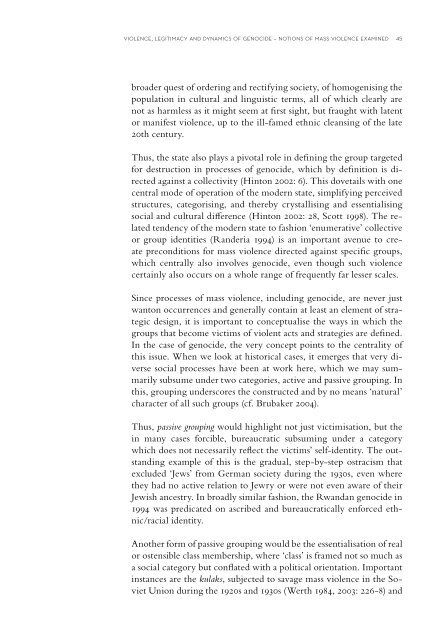60 years after the UN Convention - Dag Hammarskjöld Foundation
60 years after the UN Convention - Dag Hammarskjöld Foundation
60 years after the UN Convention - Dag Hammarskjöld Foundation
You also want an ePaper? Increase the reach of your titles
YUMPU automatically turns print PDFs into web optimized ePapers that Google loves.
violence, legitimacy and dynamics of genocide – notions of mass violence examined 45<br />
broader quest of ordering and rectifying society, of homogenising <strong>the</strong><br />
population in cultural and linguistic terms, all of which clearly are<br />
not as harmless as it might seem at fi rst sight, but fraught with latent<br />
or manifest violence, up to <strong>the</strong> ill-famed ethnic cleansing of <strong>the</strong> late<br />
20th century.<br />
Thus, <strong>the</strong> state also plays a pivotal role in defi ning <strong>the</strong> group targeted<br />
for destruction in processes of genocide, which by defi nition is directed<br />
against a collectivity (Hinton 2002: 6). This dovetails with one<br />
central mode of operation of <strong>the</strong> modern state, simplifying perceived<br />
structures, categorising, and <strong>the</strong>reby crystallising and essentialising<br />
social and cultural diff erence (Hinton 2002: 28, Scott 1998). The related<br />
tendency of <strong>the</strong> modern state to fashion ‘enumerative’ collective<br />
or group identities (Randeria 1994) is an important avenue to create<br />
preconditions for mass violence directed against specifi c groups,<br />
which centrally also involves genocide, even though such violence<br />
certainly also occurs on a whole range of frequently far lesser scales.<br />
Since processes of mass violence, including genocide, are never just<br />
wanton occurrences and generally contain at least an element of strategic<br />
design, it is important to conceptualise <strong>the</strong> ways in which <strong>the</strong><br />
groups that become victims of violent acts and strategies are defi ned.<br />
In <strong>the</strong> case of genocide, <strong>the</strong> very concept points to <strong>the</strong> centrality of<br />
this issue. When we look at historical cases, it emerges that very diverse<br />
social processes have been at work here, which we may summarily<br />
subsume under two categories, active and passive grouping. In<br />
this, grouping underscores <strong>the</strong> constructed and by no means ‘natural’<br />
character of all such groups (cf. Brubaker 2004).<br />
Thus, passive grouping would highlight not just victimisation, but <strong>the</strong><br />
in many cases forcible, bureaucratic subsuming under a category<br />
which does not necessarily refl ect <strong>the</strong> victims’ self-identity. The outstanding<br />
example of this is <strong>the</strong> gradual, step-by-step ostracism that<br />
excluded ‘Jews’ from German society during <strong>the</strong> 1930s, even where<br />
<strong>the</strong>y had no active relation to Jewry or were not even aware of <strong>the</strong>ir<br />
Jewish ancestry. In broadly similar fashion, <strong>the</strong> Rwandan genocide in<br />
1994 was predicated on ascribed and bureaucratically enforced ethnic/racial<br />
identity.<br />
Ano<strong>the</strong>r form of passive grouping would be <strong>the</strong> essentialisation of real<br />
or ostensible class membership, where ‘class’ is framed not so much as<br />
a social category but confl ated with a political orientation. Important<br />
instances are <strong>the</strong> kulaks, subjected to savage mass violence in <strong>the</strong> Soviet<br />
Union during <strong>the</strong> 1920s and 1930s (Werth 1984, 2003: 226-8) and

















